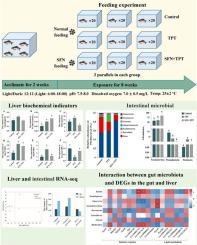Multi-omics analysis of gut-liver axis reveals the mechanism by which sulforaphane alleviates liver injury in Cyprinus carpio exposed to triphenyltin
IF 2.2
2区 生物学
Q4 BIOCHEMISTRY & MOLECULAR BIOLOGY
Comparative Biochemistry and Physiology D-Genomics & Proteomics
Pub Date : 2025-09-24
DOI:10.1016/j.cbd.2025.101642
引用次数: 0
Abstract
This study investigates the protective effects of sulforaphane (SFN) against triphenyltin (TPT)-induced hepatotoxicity, immune dysfunction and gut microbiota dysbiosis in Cyprinus carpio. Cyprinus carpio were divided into three groups and exposed for 8 weeks, including control, 10 μg/L TPT and 10 μg/L TPT + 10 mg/kg SFN group. This result showed that TPT exposure induced significantly (P < 0.05) hepatotoxicity, evidenced by increasing hepatic total bile acid (TBA) and total cholesterol levels, while upregulating Hsp70/90 and downregulating lysozyme gene expression. SFN supplementation reduced TBA accumulation, normalized Hsp90 and lysozyme expression, mitigating TPT-induced lipid dysregulation and immunosuppression. Transcriptomic analysis revealed that TPT exposure activated lipid metabolism pathways (PPAR signaling and cholesterol metabolism), but suppressed immune-related pathways. SFN supplementation restored metabolic homeostasis by enriching glucose and amino acid metabolism pathways and activating AMPK signaling, while also modulating the expression of key genes (PLIN1, ME1, CPT1B). The microbiota composition were changed in SFN + TPT, including the increased of beneficial Fusobacteriota and Cetobacterium, and the decreased of pathogenic Proteobacteria and Aeromonas. The gut transcriptome dysregulation were restored in SFN + TPT by enhancing immune pathways in Toll-like/NOD-like receptors. The significant correlations linked were found in gut microbes (Kaistia, Vagococcus) to hepatic/intestinal gene expression in SFN + TPT. Overall, these findings elucidate novel mechanisms underlying TPT-induced immunotoxicity in liver and intestine and demonstrate the protective role of SFN, providing a theoretical foundation for its application in toxicity mitigation strategies.

肠-肝轴多组学分析揭示了萝卜硫素缓解三苯基锡对鲤肝损伤的机制。
本研究探讨了萝卜硫素(SFN)对三苯基锡(TPT)诱导的鲤肝毒性、免疫功能障碍和肠道菌群失调的保护作用。鲫鱼分为对照组、10 μg/L TPT组和10 μg/L TPT + 10 mg/kg SFN组,每组暴露8周。结果表明,TPT暴露显著诱导(P
本文章由计算机程序翻译,如有差异,请以英文原文为准。
求助全文
约1分钟内获得全文
求助全文
来源期刊
CiteScore
5.10
自引率
3.30%
发文量
69
审稿时长
33 days
期刊介绍:
Comparative Biochemistry & Physiology (CBP) publishes papers in comparative, environmental and evolutionary physiology.
Part D: Genomics and Proteomics (CBPD), focuses on “omics” approaches to physiology, including comparative and functional genomics, metagenomics, transcriptomics, proteomics, metabolomics, and lipidomics. Most studies employ “omics” and/or system biology to test specific hypotheses about molecular and biochemical mechanisms underlying physiological responses to the environment. We encourage papers that address fundamental questions in comparative physiology and biochemistry rather than studies with a focus that is purely technical, methodological or descriptive in nature.

 求助内容:
求助内容: 应助结果提醒方式:
应助结果提醒方式:


